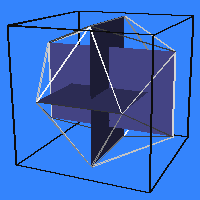 Exercise:
Construct an icosahedron inscribed
in a cube and see how the 12 vertices of the icosahedron relate to the
12 edges of the cube.
Exercise:
Construct an icosahedron inscribed
in a cube and see how the 12 vertices of the icosahedron relate to the
12 edges of the cube.
Answer: This model illustrates. Six of the thirty icosahedron edges and all twelve of its vertices lie on faces of the cube. Each icosahedron vertex lies near one cube edge and there is clearly the same number of icosahedron vertices as cube edges.
The icosahedron is shown here only as white edges, to reveal three rectangular panels, parallel to the cube's faces, constructed within it. The twelve vertices of the icosahedron are the corners of these blue panels. The three panels are golden rectangles, meaning the ratio of their length to width is the golden ratio, approximately 1.61803. You can make a paper model of the three panels with three partially slit index cards.
Another relation is observed if one turns the model to look directly down through a vertex of the cube to the center. One sees that a triangular face of the icosahedron is directly facing the cube vertex. Every 3-fold axis of symmetry of the cube is a 3-fold axis of symmetry of the icosahedron. (But the icosahedron also has six additional 3-fold axes irrelevant to the cube.)
In addition, note that this cube distinguishes a group of six among the set of thirty icosahedron edges. Six of the icosahedron edges lie in the planes of the cube and define the directions of the cubes edges. There are three parallel opposite pairs, and these three pairs are mutually orthogonal. The thirty edges can be separated into five such orthogonally related groups of six. If we simultaneously construct one cube based on each of the five groups of edges, they would form the compound of five cubes.
Finally, from the model, observe that it is easy to list the (x,y,z) coordinates of the twelve vertices:
- (+/- 1, +/- tao, 0),
- (0, +/- 1, +/- tao), and
- (+/- tao, 0, +/- 1),
where tao is the golden ratio. This would be handy to know if you should ever want to make a computer model of an icosahedron.